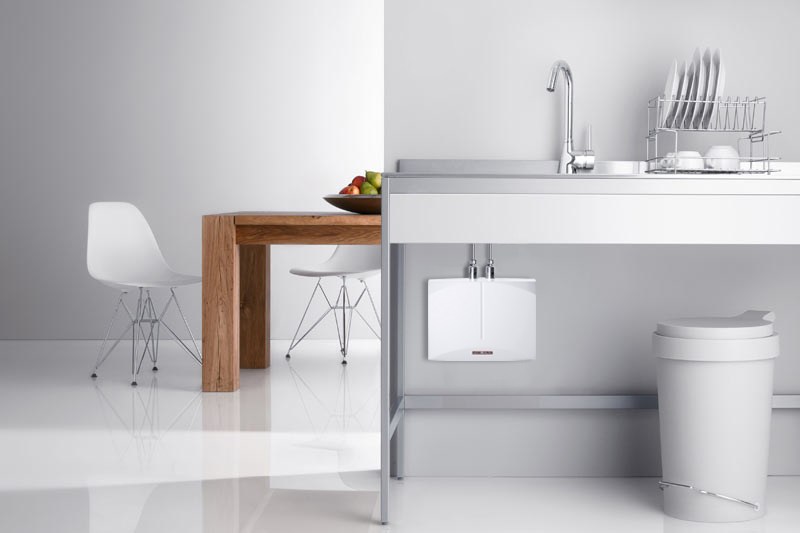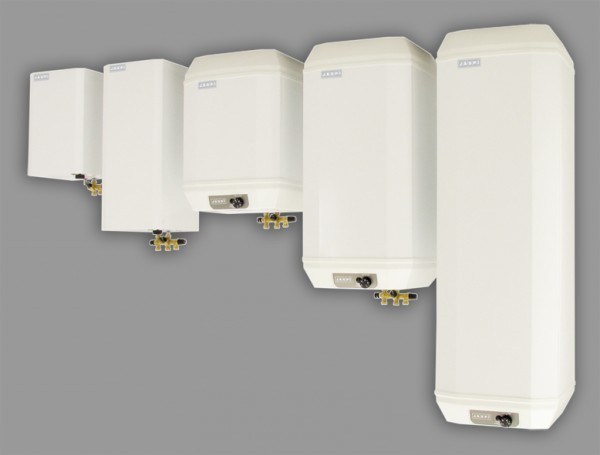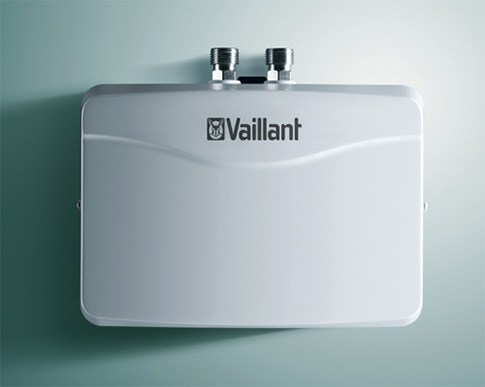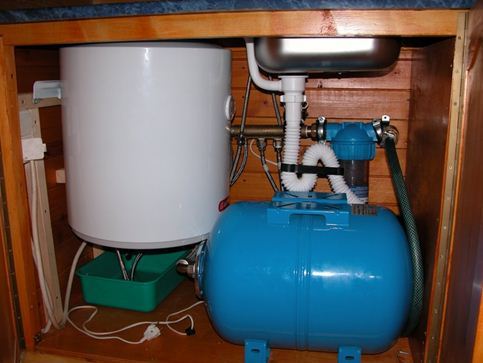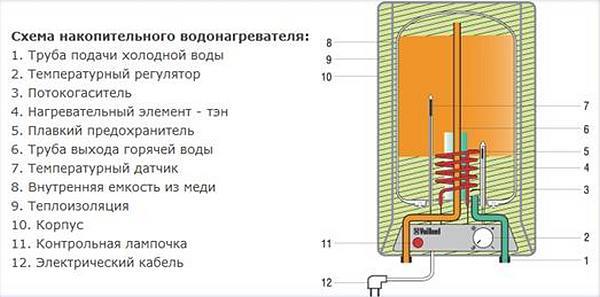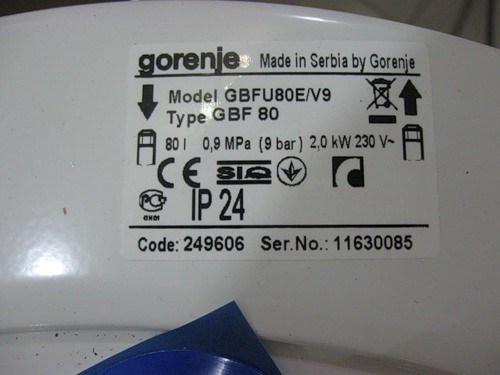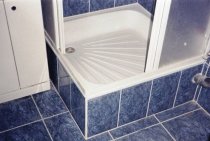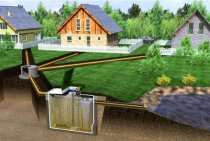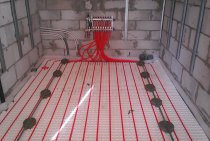A water heater under the sink can be extremely necessary in some cases.
- In the event of a complete lack of hot water.
In rooms, without any problems, it will be possible to install a water heater under a sink of a suitable size. - For active use in the summer season.
In many cities, it is in summer that hot water is most often turned off for diagnostics, construction or repair of water networks. In order not to feel difficulties with the constant heating of water for various household needs, many inhabitants install this kind of equipment in their homes. - In the event of an unexpected emergency shutdown
supply of heated water when repairs can be carried out in the house or pipes are changed. Then you can choose a device of small volume. An ordinary household water heater can be safely placed both under the sink and on the walls, while it will not cause any trouble.


Water heater under the sink: varieties and which one to choose
By and large, a water heater for a kitchen is not much different from all other similar devices - it is still the same container in which the heating element is placed and all the same two pipes for connecting the device to the water supply. Here, even the varieties are exactly the same - like its large-sized relatives, devices of this type can have a flow and storage principle of operation.
The only difference concerns only storage tanks, which differ in their small size and capacity. It is understandable, since in the kitchen, or rather under the sink, a large tank cannot be placed. This is the main criterion for choosing a water heater - you need a small device and a sufficient amount of hot water.
On sale you can find tanks from 10 to 25 liters, but the fact is that they are ineffective for heavily used kitchens in large families. In this regard, it is better to give preference to instantaneous water heaters, which are able to heat water in any volume. Their only drawback is their high power consumption.
Types of water heaters
According to the conditions of the task, we need a compact device for flush mounting. Accordingly, geysers disappear: it is impossible to mount a device of this class in a pedestal under a sink or washbasin.
Flowing
When the tap is open, water passes through the heat exchanger and, in contact with it, heats up. The heat source is an ordinary heating element - a sealed tubular heater with a tungsten coil and ceramic insulators inside.
“Adult” flow heaters can have a very significant energy consumption. In particular, in hotels and large cottages you can find devices with an electrical power of 12-24 kilowatts. No wonder: water has a significant heat capacity, and at a high flow rate it is not easy to provide an acceptable temperature.
However, for installation under the sink, we will look at relatively low-power heaters - from 3.5 to 7 kW. In order to provide hot water to one plumbing fixture, their performance is sufficient.
What is the difference between flow heaters?
- Rated power. On thematic forums, you can find very different estimates of the effectiveness of devices with a power of 3.5 kilowatts: someone speaks of them with enthusiasm, someone complains about the low water temperature.
The secret is simple: if the heater is able to heat a certain amount of water per unit of time by 15 degrees, then at an initial temperature of +5 and +20, the result will be, you know, very different.If you live in a cold region, it is better to splurge on a more powerful device, since the price of a 5-kilowatt and 3.5-kilowatt device differs slightly. - Installation method. If the device is designed to work under pressure, it is mounted in a pipeline break and turns on when water flows through any connected plumbing fixture.
- Possibility of step adjustment of power. If in all devices that consume 5 kilowatts or more, it is present, then in 3.5 kilowatts there is often only one key that turns on water heating at rated power. In the heat of summer, the ability to limit heating is often lacking.
Most inexpensive devices, however, are installed after the valves and are equipped with their own gander or shower hose with a watering can. It is not difficult to install such a device with your own hands, but you will have to solve the problem of installing a through valve in front of the heater.
Cumulative
Storage electric water heaters under the sink also fit perfectly. Of course, with a small volume.
How small? Everything is determined by the size of the cabinet and whether it is used for something else.
A device with a volume of 10 - 15 liters will fit perfectly in the cramped cabinet next to a trash can or homemade pickles; with a volume of 30 liters, there will be no more free space under the sink.
Comparison of solutions
What arguments can be made in favor of both types of devices?
Flowing
They are extremely compact and, due to their low weight, can even be mounted on a plasterboard partition. Of course, the fixing screws must fall on the frame profile.
- As a result, flow heaters are more economical than storage heaters. All the electricity they consume is used to heat water; the competing solution dissipates much of the heat uselessly. The fact is that, despite the thermal insulation of the tank, the water in it still cools down.
- The amount of hot water is unlimited. It will flow for as long as the tap is open and power is supplied to the device.
Cumulative
As a rule, the rated power of these devices does not exceed 3.5 kilowatts. This feature is very useful in houses with old wiring and in summer cottages.
Washing, you can safely open the tap completely. Water will remain consistently hot at any pressure. However, it will be enough for a short time at high consumption: as we have already found out, storage water heaters under the sink must have a small volume.
What to consider when choosing
If you plan to buy a heater to use it exclusively during preventive maintenance of the central hot water supply, it does not make sense to spend money on an expensive model. In the summer, you will completely get by with a flowing boiler of low power with a small declared volume of water supply.

Power is the main characteristic. And it's not just the speed of heating. The importance of this issue lies in the fact that in most apartment buildings it is not possible to install high-capacity water heaters due to poor electrical wiring. You can independently connect devices up to 5 kW, then you will have to connect to the shield with a separate thick wire. The most low-power are storage boilers. You can find small models starting from 0.8 kW.

Tap heaters, flow boilers consume approximately 3.5 to 7 kW. Electrical appliances of higher power do not need to be installed in the kitchen.
Since an electric water heater combines 2 potentially dangerous things: water and electricity, everything related to safe operation must be taken into account when choosing. A good boiler is equipped with a residual current device (RCD). Protection against overheating of water and automatic shutdown in case of “dry” switching on should be installed. And don't forget grounding.
So which water heater is better - storage or instantaneous
Storage heaters take up more space and are more expensive, but their power consumption is lower than in flow heaters (up to 3.5 kW), and they can provide a larger volume of hot water per minute.
Since the instantaneous water heater has a relatively high power for domestic consumption - up to 8 kW, you need to make sure that the electrical network in the apartment or house is able to provide it without constantly “knocking out” the machines. If the heater is intended only for the period of pressure testing by the heating system, when hot water is turned off for 2 weeks in summer, then heating 2 l / min will require a power of no more than 3.6 kW. Cold "winter" water cannot be heated in such a volume even up to 30 ° C. For year-round consumption, either a storage water heater or a high-power instantaneous water heater is more suitable.
When you first turn on the storage device, it will take some time to heat the water, the flow devices can immediately heat from 1.8 to 4 liters per minute.
That is, both types of water heaters have both advantages and disadvantages, and the choice in favor of one of them is only a matter of consumer preferences.
But for a country house, in the absence of main water supply, a non-pressure water heater is indispensable, which is equipped with a special small-diameter mixer to obtain a stronger jet. To create pressure, it is equipped with a hydraulic pressure switch. If the cottage is not used in winter, it can even be removed and reinstalled in the spring - its installation is so simple.
Conclusion
Hot water in the kitchen for many residents of small towns in the warm season was not available.
It will not be difficult to install the device under the sink; you can do it yourself, having the appropriate skills.
A water heater installed in the kitchen under the sink or on the sink helps out in the event of a power outage. Such a boiler will be no less useful in country conditions.
